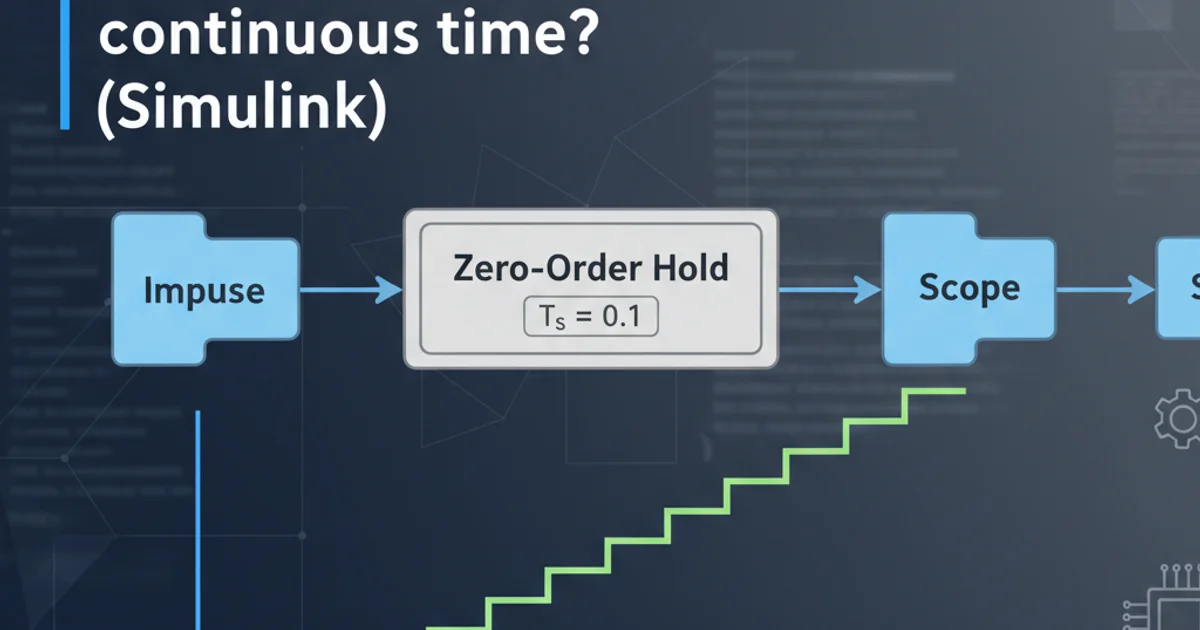How to hold impulse signal in continuous time? (Simulink)
Categories:
Holding Impulse Signals in Simulink for Continuous-Time Systems

Learn how to effectively capture and hold impulse signals within continuous-time Simulink models, addressing common challenges and providing practical solutions.
In Simulink, especially when working with continuous-time systems, accurately representing and holding an impulse signal can be a common challenge. An ideal impulse is a theoretical concept with infinite amplitude and infinitesimal duration, making it difficult to directly simulate and hold in a discrete-time environment or when interacting with continuous blocks. This article explores practical methods to achieve this, focusing on the Zero-Order Hold block and its application.
Understanding the Challenge of Impulse Signals
An impulse signal, often represented by the Dirac delta function, has a value of infinity at t=0 and zero elsewhere, with an integral of 1. In a digital simulation environment like Simulink, an ideal impulse cannot be perfectly replicated. Instead, it's typically approximated as a pulse of very short duration and high amplitude, or as a single non-zero sample in discrete time. When this 'impulse' needs to interact with continuous-time blocks and its value needs to be maintained for a certain period, a simple connection often isn't sufficient, as the signal will immediately return to zero after its brief 'impulse' duration.
flowchart TD
A[Impulse Generator] --> B{Continuous-Time System}
B --> C[Output]
subgraph Problem
A -- "Brief Pulse" --> B
B -- "Signal drops to 0" --> C
end
style Problem fill:#f9f,stroke:#333,stroke-width:2pxDirect connection of an impulse to a continuous system often results in a fleeting signal.
Solution: The Zero-Order Hold Block
The most straightforward and effective way to 'hold' an impulse signal in Simulink for continuous-time processing is by using the Zero-Order Hold (ZOH) block. The ZOH block samples its input at a specified rate and holds that sampled value constant until the next sampling instant. This effectively converts a discrete-time signal (like a single-sample impulse) into a continuous-time staircase signal, where each step corresponds to a held sample value.
Implementing Zero-Order Hold for Impulse Signals
To implement this, you typically connect an impulse source (e.g., a Pulse Generator configured for a single pulse or a 'Hit Crossing' block combined with a 'Constant' and 'Switch') to the Zero-Order Hold block. The ZOH block's sample time should be chosen carefully. If you want to hold the impulse for a specific duration, set the ZOH sample time to that duration. If the impulse is a single event, the ZOH will capture its value and hold it until the next sample time, which can be set to a sufficiently long period or triggered by another event.
% Example of setting up a Pulse Generator for a single impulse
% This is conceptual, as ZOH is a block, not a MATLAB function.
% In Simulink, you'd configure the Pulse Generator block directly.
% Pulse Generator parameters (Simulink block dialog):
% Amplitude: 1
% Period: inf (or a very large number)
% Pulse Width: 0.1% (or smallest possible for a 'spike')
% Phase delay: 0
% Zero-Order Hold block parameters:
% Sample time: [desired_hold_duration] (e.g., 1 for 1 second hold)
Conceptual parameters for a Pulse Generator and Zero-Order Hold block in Simulink.
flowchart TD
A["Pulse Generator (Single Pulse)"] --> B["Zero-Order Hold (ZOH)"]
B --> C["Continuous-Time System (e.g., Integrator)"]
C --> D["Scope (Output)"]
subgraph Solution
A -- "Discrete Impulse" --> B
B -- "Held Constant Value" --> C
end
style Solution fill:#cfc,stroke:#333,stroke-width:2pxSimulink setup to hold an impulse signal using a Zero-Order Hold block.
1. Add a Pulse Generator
Drag a 'Pulse Generator' block from the 'Sources' library into your Simulink model. Configure its parameters to generate a single, short pulse. Set 'Amplitude' to 1, 'Period' to inf (or a very large number like 1e6), and 'Pulse Width' to a very small percentage (e.g., 0.1%). Set 'Phase delay' to 0.
2. Add a Zero-Order Hold Block
Drag a 'Zero-Order Hold' block from the 'Discrete' library into your model. Connect the output of the 'Pulse Generator' to the input of the 'Zero-Order Hold' block.
3. Configure ZOH Sample Time
Double-click the 'Zero-Order Hold' block and set its 'Sample time' parameter. This value determines how long the impulse signal will be held. For example, setting it to 1 will hold the impulse's value for 1 second. Connect the output of the ZOH block to your continuous-time system.
4. Observe the Output
Add a 'Scope' block to visualize the output of the ZOH and your continuous-time system. You will observe that the ZOH output remains constant at the impulse's amplitude for the specified sample time, effectively 'holding' the impulse.